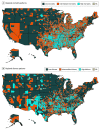Longitudinal Trajectories and Factors Associated With US County-Level Cardiovascular Mortality, 1980 to 2014
- PMID: 34846526
- PMCID: PMC8634057
- DOI: 10.1001/jamanetworkopen.2021.36022
Longitudinal Trajectories and Factors Associated With US County-Level Cardiovascular Mortality, 1980 to 2014
Abstract
Importance: Cardiovascular (CV) mortality has declined for more than 3 decades in the US. However, differences in declines among residents at a US county level are not well characterized.
Objective: To identify unique county-level trajectories of CV mortality in the US during a 35-year study period and explore county-level factors that are associated with CV mortality trajectories.
Design, setting, and participants: This longitudinal cross-sectional analysis of CV mortality trends used data from 3133 US counties from 1980 to 2014. County-level demographic, socioeconomic, environmental, and health-related risk factors were compiled. Data were analyzed from December 2019 to September 2021.
Exposures: County-level characteristics, collected from 5 county-level data sets.
Main outcomes and measures: Cardiovascular mortality data were obtained for 3133 US counties from 1980 to 2014 using age-standardized county-level mortality rates from the Global Burden of Disease study. The longitudinal K-means approach was used to identify 3 distinct clusters based on underlying mortality trajectory. Multinomial logistic regression models were constructed to evaluate associations between county characteristics and cluster membership.
Results: Among 3133 US counties (median, 49.5% [IQR, 48.9%-50.5%] men; 30.7% [IQR, 27.1%-34.4%] older than 55 years; 9.9% [IQR, 4.5%-22.7%] racial minority group [individuals self-identifying as Black or African American, American Indian or Alaska Native, Asian, Native Hawaiian, Pacific Islander, other, or multiple races/ethnicities]), CV mortality declined by 45.5% overall and by 38.4% in high-mortality strata (694 counties), by 45.0% in intermediate-mortality strata (1382 counties), and by 48.3% in low-mortality strata (1057 counties). Counties with the highest mortality in 1980 continued to demonstrate the highest mortality in 2014. Trajectory groups were regionally distributed, with high-mortality trajectory counties focused in the South and in portions of Appalachia. Low- vs high-mortality groups varied significantly in demographic (racial minority group proportion, 7.6% [IQR, 4.1%-14.5%]) vs 23.9% [IQR, 6.5%-40.8%]) and socioeconomic characteristics such as high-school education (9.4% [IQR, 7.3%-12.6%] vs 20.1% [IQR, 16.1%-23.2%]), poverty rates (11.4% [IQR, 8.8%-14.6%] vs 20.6% [IQR, 17.1%-24.4%]), and violent crime rates (161.5 [IQR, 89.0-262.4] vs 272.8 [IQR, 155.3-431.3] per 100 000 population). In multinomial logistic regression, a model incorporating demographic, socioeconomic, environmental, and health characteristics accounted for 60% of the variance in the CV mortality trajectory (R2 = 0.60). Sociodemographic factors such as racial minority group proportion (odds ratio [OR], 1.70 [95% CI, 1.35-2.14]) and educational attainment (OR, 6.17 [95% CI, 4.55-8.36]) and health behaviors such as smoking (OR for high vs low, 2.04 [95% CI, 1.58-2.64]) and physical inactivity (OR, 3.74 [95% CI, 2.83-4.93]) were associated with the high-mortality trajectory.
Conclusions and relevance: Cardiovascular mortality declined in all subgroups during the 35-year study period; however, disparities remained unchanged during that time. Disparate trajectories were associated with social and behavioral risks. Health policy efforts across multiple domains, including structural and public health targets, may be needed to reduce existing county-level cardiovascular mortality disparities.
Conflict of interest statement
Figures



Similar articles
-
County-Level Factors and Mortality Among Pacific Islander Compared With Asian American Adults.JAMA Netw Open. 2025 Jun 2;8(6):e2514248. doi: 10.1001/jamanetworkopen.2025.14248. JAMA Netw Open. 2025. PMID: 40478573 Free PMC article.
-
Assessment of Racial Disparities in Mortality Rates Among Older Adults Living in US Rural vs Urban Counties From 1968 to 2016.JAMA Netw Open. 2020 Aug 3;3(8):e2012241. doi: 10.1001/jamanetworkopen.2020.12241. JAMA Netw Open. 2020. PMID: 32744631 Free PMC article.
-
Associations of Race/Ethnicity and Food Insecurity With COVID-19 Infection Rates Across US Counties.JAMA Netw Open. 2021 Jun 1;4(6):e2112852. doi: 10.1001/jamanetworkopen.2021.12852. JAMA Netw Open. 2021. PMID: 34100936 Free PMC article.
-
Reducing Cardiovascular Disparities Through Community-Engaged Implementation Research: A National Heart, Lung, and Blood Institute Workshop Report.Circ Res. 2018 Jan 19;122(2):213-230. doi: 10.1161/CIRCRESAHA.117.312243. Circ Res. 2018. PMID: 29348251 Free PMC article. Review.
-
Social Determinants of Health, Cardiovascular Risk Factors, and Atherosclerotic Cardiovascular Disease in Individuals of Vietnamese Origin.Am J Cardiol. 2023 Feb 15;189:11-21. doi: 10.1016/j.amjcard.2022.11.028. Epub 2022 Dec 5. Am J Cardiol. 2023. PMID: 36481374 Free PMC article. Review.
Cited by
-
Cardiovascular Disease Mortality in Mississippi, 2000-2018.Prev Chronic Dis. 2022 Feb 24;19:E09. doi: 10.5888/pcd19.210385. Prev Chronic Dis. 2022. PMID: 35201975 Free PMC article.
-
American Heart Association EPI|Lifestyle Scientific Sessions: 2021 Meeting Highlights.J Am Heart Assoc. 2022 Mar;11(5):e024765. doi: 10.1161/JAHA.121.024765. Epub 2022 Feb 18. J Am Heart Assoc. 2022. PMID: 35179039 Free PMC article. No abstract available.
-
Trends in Cardiovascular Disease Mortality by County-Level Social Vulnerability Index in the United States.J Am Heart Assoc. 2023 Oct 17;12(20):e030290. doi: 10.1161/JAHA.123.030290. Epub 2023 Oct 7. J Am Heart Assoc. 2023. PMID: 37804196 Free PMC article.
-
Geographically Weighted Modeling to Explore Social and Environmental Factors Affecting County-Level Cardiovascular Mortality in People With Diabetes in the United States: A Cross-Sectional Analysis.Am J Cardiol. 2023 Dec 15;209:193-198. doi: 10.1016/j.amjcard.2023.09.084. Epub 2023 Oct 18. Am J Cardiol. 2023. PMID: 37865123 Free PMC article.
-
Empagliflozin: Primus Inter Pares Among Sodium-Glucose Cotransporter-2 Inhibitors?J Cardiovasc Pharmacol. 2024 Sep 1;84(3):271-275. doi: 10.1097/FJC.0000000000001605. J Cardiovasc Pharmacol. 2024. PMID: 39027982 Review.
References
-
- Havranek EP, Mujahid MS, Barr DA, et al. ; American Heart Association Council on Quality of Care and Outcomes Research, Council on Epidemiology and Prevention, Council on Cardiovascular and Stroke Nursing, Council on Lifestyle and Cardiometabolic Health, and Stroke Council . Social determinants of risk and outcomes for cardiovascular disease: a scientific statement from the American Heart Association. Circulation. 2015;132(9):873-898. doi:10.1161/CIR.0000000000000228 - DOI - PubMed

